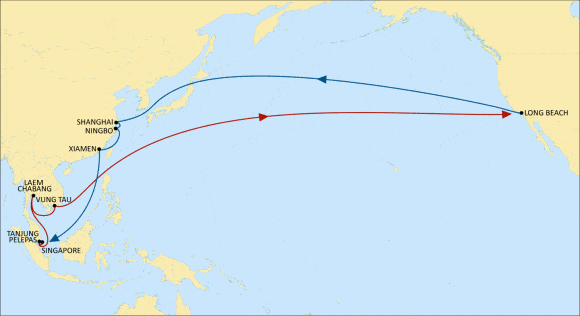The Port of Long Beach announced Wednesday “an unseasonable surge in cargo” had led to its busiest February on record.
That surge has put the entire container shipping world’s focus on California’s San Pedro Bay, where historic congestion has resulted in an unprecedented backlog of vessels laden with cargo waiting for berth space.
“We understand that shippers are awaiting their cargo and we are collaborating with our industry partners to deliver shipments as quickly as possible,” Port of Long Beach Executive Director Mario Cordero said in a press release.
“The supply chain workforce is giving its all to keep the cargo moving, even as their ranks are hit by the pandemic. New records are being set, demonstrating how busy they have been,” Cordero said.
Both the ports of Long Beach and Los Angeles have been hit with major outbreaks of COVID-19 among longshore workers since the pandemic spread to American shores late last winter. In his State of the Port address last month, Cordero called for the vaccination of dockworkers to ensure proper staffing to work through the mounds of cargo.
“I’ve called on my fellow port directors in the American Association of Port Authorities to advocate that waterfront workers receive the COVID-19 vaccine immediately. The workforce is essential to keeping our economy moving — and they have put their health on the line,” Cordero said in his early-February speech.
No slowdown in cargo
The dockworkers haven’t had time to catch a breath even as the number of reported COVID-19 cases nationwide eases. February typically is slow at the world’s ports as Asian factories close for two weeks to celebrate the Lunar New Year. But world events have been anything but typical over the past 12 months and most Chinese factories worked through the holiday this year in an attempt to fill back orders and meet e-commerce demands, which have not waned as pandemic-caused restrictions have been lifted.
The goods churned out by the Chinese factories flowed across the Pacific and thus added to the cargo heap in Southern California. The Port of Long Beach reported Wednesday it moved 771,735 twenty-foot equivalent units in February, a 43.3% jump from the 538,428 TEUs handled the same month last year and “the largest year-over-year increase for a single month in the port’s 110-year history.”
“It was also the first time the Port of Long Beach handled more than 700,000 TEUs in the month of February, exceeding the previous record set in February 2018 by 109,945 TEUs,” it said.
Imports were up 50.3% year-over-year to 373,756 TEUs, from 248,592 in February 2020. Exports declined 4.9% from 125,559 TEUs to 119,416.

But it is the number of empty containers that has been sticking out on U.S. port reports, and Long Beach’s was jarring. The number of empty containers moved through the port in February shot up 69.6%, to 278,563 TEUs. The vast majority, 265,431 TEUs, were empties moved outbound — back to Asia.
The Port of Long Beach did not respond by publication time to American Shipper’s question regarding the number of empty containers, but Northwest Seaport Alliance CEO John Wolfe said last week that the container lines just want to get the boxes back to Asia to be refilled.
“Because of the significant demand in imports into the country from Asia, the vessel operators are increasing the eastbound rates that they charge to the cargo owners for the movement of goods from Asia into the U.S., and that is creating greater profitability for the carriers,” Wolfe said. “And as a result of that, they are anxious to get those vessels with the equipment, whether it’s a load or an empty, back to Asia so they can take advantage of the higher rates that they’re enjoying today in the marketplace.”
The Port of Long Beach said in Wednesday’s press release that it “continues to collaborate with stakeholders to facilitate the efficient movement of cargo.”
‘Considerable systemic pressure’
MSC Mediterranean Shipping Company announced Wednesday that it is taking action to meet customer demand and improve reliability on the trans-Pacific trade “at a time when the entire market remains under considerable systemic pressure.”
MSC expects to commence the Sentosa service in early April. The MSC Ornella will have a rotation of Singapore; Tanjung Pelepas, Malaysia; Laem Chabang, Thailand; Vung Tau, Vietnam; Long Beach; Shanghai, Ningbo and Xiamen, China; and back to Singapore.
The Sentosa service “should enable a significantly improved transit time for MSC customers shipping goods between Southeast Asia and California, ensuring that MSC retains a direct Laem Chabang-Long Beach call in both directions within its trans-Pacific network. This compensates for the removal of a Laem Chabang-U.S. call on the Jaguar service,” Wednesday’s announcement said.
The vessel in the new Jaguar rotation will sail from Nansha to Yantian, China, across the Pacific to Long Beach and Oakland, California, and then to back to Asia, calling Busan, South Korea, before returning to China.
MSC said it was making the changes to its east-west network “to better manage the current industrywide challenging market situation, which is impacting port activities and generating congestion across the supply chain.”
Ocean carriers take heat for profiting ‘so handsomely’ while service plunged
Hapag-Lloyd CEO: COVID, congestion, container shortage form ‘perfect storm’
Port of Long Beach has best January on record
Click here for more American Shipper/FreightWaves stories by Senior Editor Kim Link-Wills.










